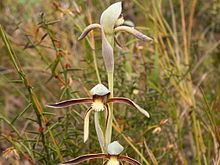Subtribe Megastylidinae Rank Species | Family Orchidaceae | |
 | ||
Similar Lyperanthus, Pterostylis recurva, Elythranthera brunonis, Elythranthera, Caladenia latifolia | ||
Lyperanthus serratus, commonly called rattle beaks, is a species of orchid which is endemic to the south-west of Western Australia. It derives its name from the fact that the flowers rattle if gently shaken.
Contents
Description
Lyperanthus serratus is a tuberous, perennial herb, 25–50 cm (10–20 in) high with 3 to 10 green, yellow and brown flowers, 3–5 cm (1–2 in) wide, from September to October. The flowers have white (non-secreting) glandular hairs on the labellum. There is a single leaf which is arched, ribbed, leathery and linear, about 35 cm (10 in) long and 1.5 cm (0.6 in) wide. A powdery bloom covers the entire plant, except for the innermost parts of the flower. The single leaf is lance-shaped, 150–350 cm (60–100 in) long and 10–15 mm (0.4–0.6 in) wide, dark green with a paler lower surface.
Taxonomy and naming
The species was first described by John Lindley in 1840 in his The Genera and Species of Orchidaceous Plants. The type specimen was collected by Drummond near the Swan River. Lindley noted "This has, when dried, so much the appearance of L. suaveolens, that I mistook it for that species. It is however a much stouter plant; and, as will be seen by the above character, the labellum is altogether different." The specific epithet (serratus) alludes to "The prominent white calli found on the labellum [which] are also distinctive and lead to the scientific name 'serratus' meaning prominent teeth."
Distribution and habitat
The species occurs in the Avon Wheatbelt, Esperance Plains, Jarrah Forest, Swan Coastal Plain and Warren biogeographical regions of Western Australia on sand, loam or sandy clay. It grows in a variety of habitats including forest, woodland and heath and often grows through reasonably low, dense vegetation.
Horticulture
As with other Australian terrestrial orchids, Lyperanthus serratus is not well known in cultivation but success has been achieved with the closely related Lyperanthus suaveolens.
